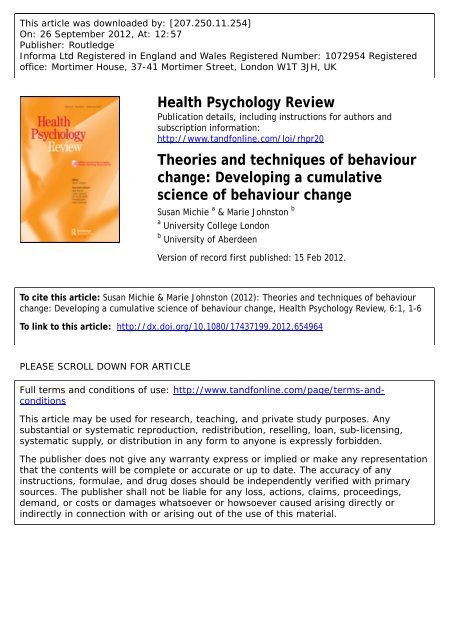Theories and techniques of behaviour change: Developing a ...
Theories and techniques of behaviour change: Developing a ...
Theories and techniques of behaviour change: Developing a ...
You also want an ePaper? Increase the reach of your titles
YUMPU automatically turns print PDFs into web optimized ePapers that Google loves.
Health Psychology ReviewVol. 6, No. 1, March 2012, 16EDITORIAL<strong>Theories</strong> <strong>and</strong> <strong>techniques</strong> <strong>of</strong> <strong>behaviour</strong> <strong>change</strong>: <strong>Developing</strong> a cumulativescience <strong>of</strong> <strong>behaviour</strong> <strong>change</strong>Downloaded by [207.250.11.254] at 12:57 26 September 2012As <strong>behaviour</strong> contributes to the cause <strong>of</strong> much current mortality <strong>and</strong> morbidity(Mokdad, Marks, Stroup, & Gerberding, 2000; Parkin, Boyd, & Walker, 2011),interventions to <strong>change</strong> <strong>behaviour</strong> are essential in prevention. Behaviour <strong>change</strong>interventions are usually complex, comprising many interacting components (Craiget al., 2008). The current issue <strong>of</strong> Health Psychology Review provides examples <strong>of</strong><strong>behaviour</strong> <strong>change</strong> interventions that are effective. However, their effectiveness isvariable, <strong>and</strong> we do not have a full underst<strong>and</strong>ing <strong>of</strong> what accounts for thisvariability. Evidence about effectiveness, sources <strong>of</strong> variation <strong>and</strong> mechanisms <strong>of</strong>action are accumulating slowly. Ineffective <strong>techniques</strong> continue to be used, whileeffective <strong>techniques</strong> are underused, difficult to replicate <strong>and</strong> their mechanisms <strong>of</strong>action are poorly understood.What is to be done to improve this situation? We suggest three main areas inwhich conceptual <strong>and</strong> methodological advances are urgently needed to enhancescientific st<strong>and</strong>ards in this area: (1) clarity about ‘<strong>behaviour</strong>’ as an outcome, (2)replicable methods for reporting the ‘active ingredients’, that is <strong>behaviour</strong> <strong>change</strong><strong>techniques</strong> (BCTs) <strong>and</strong> (3) linking <strong>behaviour</strong>al interventions <strong>and</strong> BCTs to theoreticalmechanisms <strong>of</strong> <strong>change</strong>.Behaviour is the outcome <strong>of</strong> <strong>behaviour</strong> <strong>change</strong> interventionsBasic psychological research over the last century has demonstrated that <strong>behaviour</strong><strong>and</strong> <strong>behaviour</strong> <strong>change</strong> follow predictable patterns. It is therefore vital thatinterventions are guided by this accumulated science. The ‘Decade <strong>of</strong> Behavior’(20002010) (http://www.decade<strong>of</strong>behavior.org) emphasised the importance <strong>of</strong><strong>behaviour</strong> in health <strong>and</strong> the relevance <strong>of</strong> research on <strong>behaviour</strong> to policy objectives.Nevertheless, opportunities may be missed because ‘<strong>behaviour</strong>’ may be given avariety <strong>of</strong> different labels, such as ‘adherence’, ‘physical activity’, etc. (Johnston &Dixon, 2008; Marteau & Johnston, 1987) or conceptualised too vaguely (Michie &Johnston, 2004); for example, the significance <strong>of</strong> precise specification <strong>of</strong> <strong>behaviour</strong>s isillustrated by McEachan, Conner, Taylor <strong>and</strong> Lawton’s (2011) finding that theTheory <strong>of</strong> Planned Behaviour may be more effective in predicting some <strong>behaviour</strong>sthan others. As a result, the best theory <strong>and</strong> methods for investigating <strong>behaviour</strong> maybe overlooked.The importance <strong>of</strong> defining <strong>behaviour</strong> as the end-point <strong>of</strong> a <strong>behaviour</strong>alintervention cannot be overstated. Very <strong>of</strong>ten, the end-point is a consequence <strong>of</strong>the <strong>behaviour</strong>, not <strong>behaviour</strong> itself (e.g. weight, blood glucose level), <strong>and</strong> the evidence<strong>of</strong> effectiveness <strong>of</strong> interventions depends on which type <strong>of</strong> outcome is specifiedISSN 1743-7199 print/ISSN 1743-7202 online# 2012 Taylor & Francishttp://dx.doi.org/10.1080/17437199.2012.654964http://www.t<strong>and</strong>fonline.com
2 Susan Michie <strong>and</strong> Marie JohnstonDownloaded by [207.250.11.254] at 12:57 26 September 2012(Dombrowski, Sniehotta, Avenell, MacLennon, & Araỳjo-Soares, 2012). Theproblem with evaluating intervention effectiveness in terms <strong>of</strong> outcomes furtherdown the causal chain (Hardeman et al., 2005) is that there are a host <strong>of</strong> influencesthat could intervene <strong>and</strong> attenuate the link between <strong>behaviour</strong> <strong>and</strong> outcome. As DiMatteo, Haskard-Zolnierek <strong>and</strong> Martin (2012) point out, the correlation betweenthe <strong>behaviour</strong>s involved in medication adherence <strong>and</strong> health outcomes may vary withthe disease condition <strong>and</strong> the appropriateness <strong>and</strong> efficacy <strong>of</strong> the treatmentprescribed. Thus, the link between an effective <strong>change</strong> in <strong>behaviour</strong> <strong>and</strong> an effecton a non-<strong>behaviour</strong>al health outcome depends on the strength <strong>of</strong> the causalrelationships established by epidemiology <strong>and</strong> medical, rather than <strong>behaviour</strong>al,sciences.For some interventions, <strong>behaviour</strong> per se is the valued health outcome, forexample, in studies to reduce activity limitations or enhance participation (Johnston,Bonetti, & Pollard, 2002). However, when the outcome is <strong>behaviour</strong>, end-points thatare early in the causal chain, such as knowledge <strong>and</strong> attitudes, are insufficient, aseven a strong effect on these cognitive outcomes will be attenuated as they aremediated through motivational <strong>and</strong> action-oriented processes to result in <strong>behaviour</strong>(Sniehotta, 2009; Webb & Sheeran, 2006).In addition, <strong>behaviour</strong>, itself, needs defining. One definition comes from amultidisciplinary consensus study <strong>of</strong> theories <strong>of</strong> <strong>behaviour</strong> <strong>change</strong>: ‘Anything aperson does in response to internal or external events. Actions may be overt (motoror verbal) <strong>and</strong> directly measurable, or covert (e.g. physiological responses) <strong>and</strong> onlyindirectly measurable; <strong>behaviour</strong>s are physical events that occur in the body <strong>and</strong> arecontrolled by the brain’ (Hobbs, Campbell, Hildon, & Michie, 2011). Behaviour mayrefer to simple, specific actions, for example, swallowing a pill; in relation to health, itis generally used to refer to more complex sequences <strong>of</strong> actions. Behaviour mayinvolve the performance <strong>of</strong> a complex sequence <strong>of</strong> actions over time; for example, DiMatteo <strong>and</strong> colleagues identify a sequence <strong>of</strong> at least four <strong>behaviour</strong>s necessary toadhere to medication advice. The processes involved <strong>and</strong> the BCTs required for<strong>behaviour</strong> <strong>change</strong> may differ for each <strong>behaviour</strong> in the sequence.Behaviour <strong>change</strong> <strong>techniques</strong>To develop our scientific underst<strong>and</strong>ing <strong>of</strong> the principles <strong>of</strong> <strong>behaviour</strong> <strong>change</strong>, weneed clear <strong>and</strong> agreed st<strong>and</strong>ards for identifying the ‘active ingredients’ <strong>and</strong> fordesigning, evaluating <strong>and</strong> reporting interventions. The scientific st<strong>and</strong>ards dem<strong>and</strong>ed,<strong>and</strong> found to be successful, for biomedical interventions are <strong>of</strong>ten ignoredwhen the intervention involves <strong>behaviour</strong> <strong>change</strong>. For example, pharmacologicalinterventions require clear specification <strong>of</strong> the chemical formula <strong>of</strong> its activeingredients <strong>and</strong> a high level <strong>of</strong> competence in the personnel prescribing them, whilst<strong>behaviour</strong> <strong>change</strong> interventions are <strong>of</strong>ten poorly specified, preventing high-fidelityreplication <strong>and</strong>, despite being complex, delivered by individuals <strong>of</strong> unreportedcompetence. Even apparently well-described methods such as cognitive <strong>behaviour</strong>therapy for pain have not been adequately described: ‘the usage <strong>of</strong> the term cognitivebehavior therapy varies widely <strong>and</strong> may include self-instructions ... relaxation orbi<strong>of</strong>eedback, development <strong>of</strong> coping strategies ... goal setting’ (Gatchel, Peng,Peters, Fuchs, & Turk, 2007, p. 606). Precise specification <strong>and</strong> descriptions arerequired: <strong>of</strong> the <strong>behaviour</strong>s to be <strong>change</strong>d, the BCTs to be used, the competences
Health Psychology Review 3Downloaded by [207.250.11.254] at 12:57 26 September 2012required to deliver them, (e.g. the competences <strong>of</strong> medical or health psychologytraining or specific health <strong>behaviour</strong> <strong>change</strong> competencies (Dixon & Johnston, 2011;Michie, Churchill, & West, 2011), their modes <strong>of</strong> delivery (e.g. leaflet, telephone,group; in hospital, at home, in community setting; weekly, one-<strong>of</strong>f, for one hour orone day) <strong>and</strong> the level <strong>of</strong> intervention (Michie, van Stralen, & West, 2011). Thisprecision allows one to establish whether, <strong>and</strong> how, BCTs have been applied to<strong>change</strong> a particular <strong>behaviour</strong> <strong>and</strong> are important in evaluating efficacy, especially insystematic reviews (Dombrowski et al., 2012; Taylor, Conner, & Lawton, 2012;Thoolen, de Ridder, & van Lensvelt-Mulders, 2012). Precise specification <strong>of</strong> BCTsmay also enhance the intervention: Taylor et al.’s (2012) meta-analysis found thatwhen BCTs were not specified, intervention effects were smaller.BCTs are observable <strong>and</strong> replicable components <strong>of</strong> <strong>behaviour</strong> <strong>change</strong> interventions.They are the smallest component compatible with retaining the postulatedactive ingredients, that is, the proposed mechanisms <strong>of</strong> <strong>change</strong>, <strong>and</strong> can be used aloneor in combination with other BCTs (Michie, Abraham, et al., 2011; Michie &Johnston, in press). Conceptualising interventions in terms <strong>of</strong> their component<strong>techniques</strong> enables the possibility <strong>of</strong> identifying the ‘active ingredients’ withininterventions. For example, using a reliable BCT coding scheme, Dombrowski et al.(2012) found that instruction, self-monitoring <strong>and</strong> practice were effective <strong>techniques</strong>.Specification also enables a further step underpinning scientific investigation,systematic classification. Both Taylor et al. (2012) <strong>and</strong> Dombrowski et al. (2012)used a reliable BCT coding scheme to identify BCTs in heterogeneous complexinterventions <strong>and</strong> evaluated their effectiveness using multivariate statistical analyses.Several <strong>behaviour</strong>-specific classifications <strong>of</strong> BCTs have been developed in recentyears in relation to different <strong>behaviour</strong> types: physical activity <strong>and</strong> healthy eating(Abraham & Michie, 2008; Michie, Ashford, et al., 2011), smoking (Michie, Hyder,Walia, & West, 2011; West, Evans, & Michie, 2011), excessive alcohol use (Michie,Whittington, Hamoudi, Zarnani, Tober, & West, in press) <strong>and</strong> condom use(Abraham, Good, Warren, Huedo-Medina, & Johnson, 2011). These have beenconstructed by identifying BCTs within written reports <strong>of</strong> the interventions, or textsdescribing interventions, in a bottom-up, inductive fashion. To date, their hierarchicalstructures have not been investigated. This is the next step for taxonomydevelopment, <strong>and</strong> Stavri <strong>and</strong> Michie’s (2012) article in this issue reviews a variety <strong>of</strong>classification schemes developed for the natural sciences, such as the Periodic Table<strong>of</strong> chemical elements <strong>and</strong> Linnaeus’s biological classification system. They identifiedsix distinct types <strong>of</strong> classification system nomenclatures, ordered sets, hierarchical,matrices, faceted <strong>and</strong> social categorisations <strong>and</strong> considered their usefulness inrelation to <strong>behaviour</strong>al science. The further development <strong>of</strong> BCT specification <strong>and</strong>classification is being taken forward using consensus methods on an internationalbasis (Michie, Abraham, et al., 2011; http://www.ucl.ac.uk/health-psychology/BCTtaxonomy).Linking BCTs with theoretical mechanisms <strong>of</strong> <strong>change</strong>Two <strong>of</strong> the articles in this themed issue used BCT taxonomies <strong>and</strong> meta-regression toinvestigate the association between theoretically coherent combinations <strong>of</strong> BCTs <strong>and</strong>intervention efficacy. Both Dombrowski et al. (2012) <strong>and</strong> Taylor et al. (2012) foundthat the number <strong>of</strong> BCTs used did not predict efficacy but having a theoretical basis
4 Susan Michie <strong>and</strong> Marie JohnstonDownloaded by [207.250.11.254] at 12:57 26 September 2012for the intervention did. Dombrowski et al. also investigated whether interventionsthat comprised BCTs that were predicted by theory to work synergistically were moreeffective than those that did not; interventions including more BCTs that werecongruent with Control Theory (Carver & Scheier, 1982) were associated with greaterweight loss (in this case, a proxy for healthy eating) in obese adult patients,replicating a similar finding by Michie, Abraham, et al. (2009) in the general adultpopulation. Taylor et al. also found that the extent to which worksite physicalactivity interventions were explicitly based on theory (using Michie & Prestwich’s(2010) theory coding scheme) predicted their effectiveness, a finding consistent with asimilar analysis <strong>of</strong> internet interventions (Webb, Joseph, Yardley, & Michie, 2010).Ideally, theories summarise the state <strong>of</strong> cumulative knowledge. They specify keyconstructs <strong>and</strong> relationships <strong>and</strong> the underlying scientific explanations <strong>of</strong> theprocesses <strong>of</strong> <strong>change</strong> <strong>and</strong> link <strong>behaviour</strong> <strong>change</strong> to constructs in a systematic way.They describe how, when <strong>and</strong> why <strong>change</strong> occurs. They allow investigators tounderst<strong>and</strong> why <strong>and</strong> how interventions succeed or fail. Rigorous testing <strong>of</strong>theoretical principles forms a basis for future interventions. Thus, theories arefundamental in designing <strong>behaviour</strong> <strong>change</strong> interventions.Key frameworks for designing <strong>and</strong> evaluating <strong>behaviour</strong> <strong>change</strong> interventions(Collins et al., 2011; Craig et al., 2008) emphasise the importance <strong>of</strong> using theory toinform intervention design as well as specifying interventions in terms <strong>of</strong> componentBCTs. However, they do not <strong>of</strong>fer guidance as to how to link the postulated theoreticalmechanisms <strong>of</strong> <strong>change</strong> with BCTs. This link is necessary both to theoretically informintervention development <strong>and</strong> to test theory by evaluating interventions. Apreliminary attempt at linking BCTs with theoretical constructs hints at the potentialusefulness <strong>of</strong> such a scheme (Michie, Johnston, Francis, Hardeman, & Eccles, 2008)but needs further work to realise the full potential for theoretical <strong>and</strong> technologicaladvance in changing <strong>behaviour</strong>, <strong>and</strong> forms part <strong>of</strong> our research programme.Conclusions: developing the science <strong>and</strong> technology <strong>of</strong> <strong>behaviour</strong> <strong>change</strong>For both scientific <strong>and</strong> practical reasons, it is essential that <strong>behaviour</strong> <strong>change</strong>interventions develop a sounder scientific basis. In practice, the science will informthe technology (i.e. the <strong>techniques</strong> <strong>and</strong> methods) required to deliver effectivereplicable interventions with guidance on their delivery to ensure that effectiveinterventions are actually used. For science, we have argued for clarity about‘<strong>behaviour</strong>’ being the defined <strong>and</strong> measured outcome <strong>of</strong> interventions rather thanother outcomes further back or further down the causal chain that leads to valuedhealth outcomes. Recent progress in classifying the active components <strong>of</strong> <strong>behaviour</strong><strong>change</strong> interventions, BCTs, has begun to produce the precision <strong>and</strong> specificityrequired to build cumulative evidence. Progress, however, will depend on linkingactive ingredients to an underst<strong>and</strong>ing <strong>of</strong> the processes involved, that is, to thetheoretical basis <strong>of</strong> <strong>behaviour</strong> <strong>change</strong>. A science <strong>of</strong> <strong>behaviour</strong> <strong>change</strong> needs bothgood theory <strong>and</strong> reliable technology.Susan Michie (University College London) <strong>and</strong>Marie Johnston (University <strong>of</strong> Aberdeen)s.michie@ucl.ac.uk
Health Psychology Review 5Downloaded by [207.250.11.254] at 12:57 26 September 2012ReferencesAbraham, C., Good, A., Warren, M.R., Huedo-Medina, T.B., & Johnson, B.T. (2011).<strong>Developing</strong> <strong>and</strong> testing a SHARP taxonomy <strong>of</strong> <strong>behaviour</strong> <strong>change</strong> <strong>techniques</strong> included incondom promotion interventions. Psychology & Health, 26(Suppl. 2), 299.Abraham, C., & Michie, S. (2008). Taxonomy <strong>of</strong> behavior <strong>change</strong> <strong>techniques</strong> used ininterventions. Health Psychology, 27, 379387. doi:10.1037/0278-6133.27.3.379.Carver, C.S., & Scheier, M.F. (1982). Control theory: A useful conceptual framework forpersonality-social, clinical, <strong>and</strong> health psychology. Psychological Bulletin, 92, 111135.Collins, L.M., Baker, T.B., Mermelstein, R.J., Piper, M.E., Jorenby, D.E., Smith, S.S., ...Fiore, M.C. (2011). The multiphase optimization strategy for engineering effective tobaccouse interventions. Annals <strong>of</strong> Behavioral Medicine, 41, 208226.Craig, P., Dieppe, P.A., Macintyre, S., Michie, S., Nazareth, I., & Petticrew, M. (2008).<strong>Developing</strong> <strong>and</strong> evaluating complex interventions: The new Medical Research Councilguidance. British Medical Journal, 337, 979983.Di Matteo, M.R., Haskard-Zolnierek, K.B., & Martin, L.R. (2012). Improving patientadherence: A three-factor model to guide practice. Health Psychology Review, 6, 7491.Dixon, D., & Johnston, M. (2011). Health <strong>behaviour</strong> <strong>change</strong>: A comprehensive competencyframework. Retrieved from http://www.healthscotl<strong>and</strong>.com/uploads/documents/14543-HBCC_framework1.pdf, accessed 5.12.2011.Dombrowski, S.U., Sniehotta, F.F., Avenell, A., MacLennon, G., & Araùjo-Soares, V. (2012).Identifying active ingredients in complex <strong>behaviour</strong>al interventions for obese adults withobesity-related co-morbidities or additional risk factors for co-morbidities: A systematicreview. Health Psychology Review, 6, 732.Gatchel, R.J., Peng, Y.B., Peters, M.L., Fuchs, P.N., & Turk, D.C. (2007). The biopsychosocialapproach to chronic pain: Scientific advances <strong>and</strong> future directions. Psychological Bulletin,133, 581624.Hardeman, W., Sutton, S., Griffin, S., Johnston, M., White, A.J., Wareham, N.J., &Kinmonth, A.L. (2005). A causal modelling approach to the development <strong>of</strong> theory-based<strong>behaviour</strong> <strong>change</strong> programmes for trial evaluation. Health Education Research, 20, 676687.Hobbs, L., Campbell, R., Hildon, Z., & Michie, S. (2011). Behaviour <strong>change</strong> theories acrosspsychology, sociology, anthropology <strong>and</strong> economics: A systematic review. Psychology &Health, 26(Suppl 1), 31.Johnston, M., Bonetti, D., & Pollard, B. (2002). Disability as <strong>behaviour</strong>: Models <strong>of</strong>measurement <strong>and</strong> explanation. In L. Backman & C. von H<strong>of</strong>ston (Eds.), Psychology atthe turn <strong>of</strong> the millennium, Vol. 1: Cognitive, Biological <strong>and</strong> Health Perspectives (pp. 319333). Sussex: Psychology Press.Johnston, M., & Dixon, D. (2008). What happened to <strong>behaviour</strong> in the decade <strong>of</strong> <strong>behaviour</strong>?Psychology <strong>and</strong> Health, 23, 509513.Marteau, T.M., & Johnston, M. (1987). Health psychology: The danger <strong>of</strong> neglectingpsychological models. Bulletin <strong>of</strong> the British Psychological Society, 40, 8285.McEachan, R.R.C., Conner, M., Taylor, N.J., & Lawton, R.J. (2011). Prospective prediction <strong>of</strong>health-related <strong>behaviour</strong>s with the theory <strong>of</strong> planned <strong>behaviour</strong>: A meta-analysis. HealthPsychology Review, 5, 97144.Michie, S., Abraham, C., Eccles, M.P., Francis, J.J., Hardeman, W., & Johnston, M. (2011).Methods for strengthening evaluation <strong>and</strong> implementation: Specifying components <strong>of</strong><strong>behaviour</strong> <strong>change</strong> interventions: A study protocol. Implementation Science, 6, 10.Michie, S., Abraham, C., Whittington, C., McAteer, J., & Gupta, S. (2009). Effective<strong>techniques</strong> in healthy eating <strong>and</strong> physical activity interventions: A meta-regression. HealthPsychology, 28, 690701.Michie, S., Ashford, S., Sniehotta, F.F., Dombrowski, S.U., Bishop, A., & French, D.P. (2011).A refined taxonomy <strong>of</strong> <strong>behaviour</strong> <strong>change</strong> <strong>techniques</strong> to help people <strong>change</strong> their physicalactivity <strong>and</strong> healthy eating <strong>behaviour</strong>s The CALO-RE taxonomy, Psychology & Health.Advance online publication. doi:10.1080/08870446.2010.540664Michie, S., Churchill, S., & West, R. (2011). Identifying evidence-based competences requiredto deliver <strong>behaviour</strong>al support for smoking cessation. Annals <strong>of</strong> Behavioural Medicine, 41,5970.
6 Susan Michie <strong>and</strong> Marie JohnstonDownloaded by [207.250.11.254] at 12:57 26 September 2012Michie, S., Fixsen, D., Grimshaw, J., & Eccles, M. (2009). Specifying <strong>and</strong> reporting complex<strong>behaviour</strong> <strong>change</strong> interventions: The need for a scientific method. Implementation Science,4, 40.Michie, S., Hyder, N., Walia, A., & West, R. (2011). Development <strong>of</strong> a taxonomy <strong>of</strong> <strong>behaviour</strong><strong>change</strong> <strong>techniques</strong> used in individual <strong>behaviour</strong>al support for smoking cessation. AddictiveBehaviors, 36, 315319.Michie, S., & Johnston, M. (2004). Changing clinical <strong>behaviour</strong> by making guidelines specific.British Medical Journal, 328, 343345.Michie, S., & Johnston, M. (in press). Behaviour <strong>change</strong> <strong>techniques</strong>. In M.D. Gellman &J.R. Turner (Eds.), Encyclopaedia <strong>of</strong> Behavioral Medicine. Springer: New York.Michie, S., Johnston, M., Francis, J., Hardeman, W., & Eccles, M. (2008). From theory tointervention: Mapping theoretically derived <strong>behaviour</strong>al determinants to <strong>behaviour</strong> <strong>change</strong><strong>techniques</strong>. Applied Psychology: An International Review, 57, 660680.Michie, S., & Prestwich, A. (2010). Are interventions theory-based? Development <strong>of</strong> a theorycoding scheme. Health Psychology, 29, 18.Michie, S., van Stralen, M.M., & West, R. (2011). The <strong>behaviour</strong> <strong>change</strong> wheel: A new methodfor characterising <strong>and</strong> designing <strong>behaviour</strong> <strong>change</strong> interventions. Implementation Science, 6,42.Michie, S., Whittington, C., Hamoudi, Z., Zarnani, F., Tober, G., & West, R. (in press).Behaviour <strong>change</strong> <strong>techniques</strong> to reduce excessive alcohol use <strong>and</strong> their associations withoutcome. Addiction.Mokdad, A.H., Marks, J.S., Stroup, D.F., & Gerberding, J.L. (2000). Actual causes <strong>of</strong> death inthe United States, 291, 1238, 2004. JAMA-Journal <strong>of</strong> the American Medical Association,293(3), 293294.Parkin, D.M., Boyd, L., & Walker, L.C. (2011). The fraction <strong>of</strong> cancer attributable to lifestyle<strong>and</strong> environmental factors in the UK in 2010. British Journal <strong>of</strong> Cancer, 105, S77S81.Sniehotta, F.F. (2009). Towards a theory <strong>of</strong> intentional <strong>behaviour</strong> <strong>change</strong>: Plans, planning, <strong>and</strong>self-regulation. British Journal <strong>of</strong> Health Psychology, 14, 261273.Stavri, Z., & Michie, S. (2012). Classification systems in <strong>behaviour</strong>al science: Current systems<strong>and</strong> lessons from the natural, medical <strong>and</strong> social sciences. Health Psychology Review, 6,112139.Taylor, N., Conner, M., & Lawton, R. (2012). The impact <strong>of</strong> theory on the effectiveness <strong>of</strong>worksite physical activity interventions: A meta-analysis <strong>and</strong> meta-regression. HealthPsychology Review, 6, 3373.Thoolen, B., de Ridder, D., & van Lensvelt-Mulders, G. (2012). Patient-oriented interventionsto improve antibiotic prescribing practices in respiratory tract infections: A meta-analysis.Health Psychology Review, 6, 92112.Webb, T.L., Joseph, J., Yardley, L., & Michie, S. (2010). Using the internet to promote health<strong>behaviour</strong> <strong>change</strong>: A systematic review <strong>and</strong> meta-analysis <strong>of</strong> the impact <strong>of</strong> theoretical basis,use <strong>of</strong> <strong>behaviour</strong> <strong>change</strong> <strong>techniques</strong>, <strong>and</strong> mode <strong>of</strong> delivery on efficacy. Journal <strong>of</strong> MedicalInternet Research, 12, 1.Webb, T.L., & Sheeran, P. (2006). Does changing behavioral intentions engender behavior<strong>change</strong>? A meta-analysis <strong>of</strong> the experimental evidence. Psychological Bulletin, 132, 249268.West, R., Evans, A., & Michie, S. (2011). Behaviour <strong>change</strong> <strong>techniques</strong> used in group-based<strong>behaviour</strong>al support by the English Stop-Smoking Services <strong>and</strong> preliminary assessment <strong>of</strong>association with short-term quit outcomes. Nicotine <strong>and</strong> Tobacco Research, 13, 13161320.
















